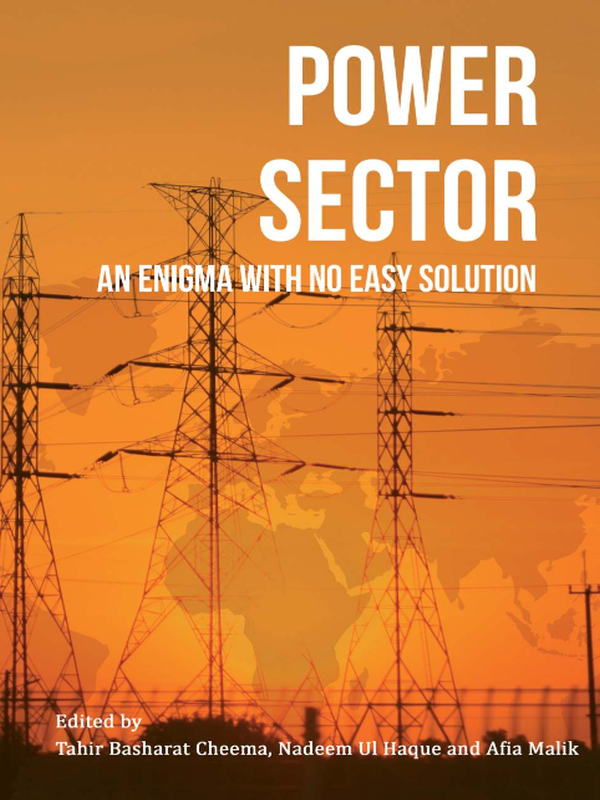
Pakistan Institute of Development Economics
- Home
Our Portals
MenuMenuMenuMenuMenuMenuMenu - ResearchMenuMenuMenuMenuMenuMenuMenu
- Discourse
- The PDR
- Our Researchers
- Academics
- Degree Verification
- Thesis Portal
- Our Portals
Power Sector: An Enigma With No Easy Solution
TABLE OF CONTENTS
Table of contents ……………………………………………………………………………………………………..i
List of Figures ………………………………………………………………………………………………………iv
List of Boxes ………………………………………………………………………………………………………vi
List of Tables …………………………………………………………………………………………………………vii
List of Acronyms…………………………………………………………………………………………………….viii
Preface…………………………………………………………………………………………………………………..xiii
Executive Summary……………………………………………………………………………………………….xvi
Pakistan power sector (June 30, 2021)……………………………………………………………………1
1. POWER SECTOR: PREMIER CHALLENGES ……………………………………..3
1.1. Financial Viability and Power Sector Losses ………………………………………….3
1.2. Supply Reliability ………………………………………………………………………………………7
1.3. Unaffordable & Uncompetitive Tariffs …………………………………………………..12
1.4. Governance ………………………………………………………………………………………………16
1.5. Corporate Governance and Management………………………………………………17
1.6. Lack of Coordinated Planning ………………………………………………………………..20
1.7. Lack of Comprehensive Policy ……………………………………………………………….23
1.8. Expensive Fuel Mix: A Planning Failure ……………………………………………….25
2. DISTRIBUTION CHALLENGES: WHY ARE DISCOS NOT DELIVERING?……….29
2.1. DISCO’s Major Challenges ………………………………………………………………………30
2.2. Poor Electricity Distribution Performance: Major Reasons ……………….36
3. EXTERNALITIES AFFECTING ELECTRICITY DISTRIBUTION ……………….47
3.1. Variation Across Distribution Companies …………………………………………….47
3.2. Externalities …………………………………………………………………………………………47
4. PRIVATIZATION OF DISTRIBUTION COMPANIES_ A FUTILE EXERCISE? …..51
4.1. Privatization of Electricity Distribution in Pakistan: History …………….52
4.2. Lessons from K-Electric Privatization for Other Distribution Companies …………………..54
4.3. Privatization of Monopoly ……………………………………………………………………..54
5. GENERATION BLUES ……………………………………………………………58
5.1. Introduction ……………………………………………………………………………………………58
5.2. GENCOs: Historical Perspective ……………………………………………………………61
5.3. Random Decision Making ……………………………………………………………………..62
6. IPPS THAT CHANGED THE POWER ARCHITECTURE IN PAKISTAN …………64
6.1. Beginning of IPPs Era in Pakistan ………………………………………………………..65
6.2. Wrong Decisions and IPP Irregularities ………………………………………………67
6.3. Role of Several Parallel Entities ……………………………………………………………72
7. POWER CONTROL AND ALLIED ISSUES ……………………………..75
7.1. Load Dispatch Center (LDC): History …………………………………………………..75
7.2. Transmission Constraints and Economic Merit Order ……………………….76
7.3. Upgradation of NPCC ……………………………………………………………………………..79
7.4. SCADA and the Data Exchange Portal …………………………………………………..81
7.5. Power Breakdowns in the NTDC System ……………………………………………..83
7.6. Delays in System Restoration after Blackouts: Reasons & Solutions …………86
8. ASSET MANAGEMENT AND PROCUREMENT IN POWER SECTOR …………88
8.1. Power Sector Procurement Process and Challenges ………………………….88
8.2. Lack of Asset Management System in NTDC ……………………………………….92
9. POWER PLANNING: FAILURES OF THE LAST THREE DECADES ………….95
9.1. Introduction ………………………………………………………………………………………95
9.2. Distribution Planning: A Missing Link …………………………………………………95
9.3. Issues in Planning Process at the NTDC ………………………………………………98
9.4. Failure of Last Three Decades……………………………………………………………..100
10. REGULATORY AFFAIRS AND CONSUMER-END TARIFF DESIGN ………….104
10.1. Establishment of NEPRA …………………………………………………………………….104
10.2. Tariff Determination …………………………………………………………………………..105
10.3. Consumer-end Tariff …………………………………………………………………………..109
10.4. Load Suppression Tariff (Increasing Block Tariff ) Model ……………….116
11. COMPETITIVE TRADING BILATERAL CONTRACT MARKET (CTBCM) …..123
11.1. Preface ……………………………………………………………………………………………………123
11.2. CTBCM Primary Commercial Features ……………………………………………….123
11.3. Current Market Structure: Single Buyer Model …………………………………125
11.4. Wholesale Market Fundamentals ………………………………………………………..126
11.5. Distributed Generation (DG) and Wheeling of Power ……………………..128
12. FUTURE ARCHITECTURE OF THE POWER SECTOR ………………………….131
12.1. Managerial Reforms ………………………………………………………………….131
12.2. Re-organize Power Institutions & Reduce Government Footprint….132
12.3. All-Inclusive Power Policy & Coordinated Planning ……………………….. 135
12.4. Establish a Power Commission ……………………………………………………………135
12.5. Power Sector Revenue Recovery Plan ………………………………………………..136
12.6. Technology and Power Sector Futures ……………………………………………….137
12.7. Indigenous Energy for Future ……………………………………………………………..140
12.8. Energy Conservation and Efficiency …………………………………………………..145
Bibliography 147
Appendix A. Power Sector and Establishment of WAPDA 151
Appendix B: Why the Reforms of the 1990s Failed? 153
Appendix C. Senior Management Challenges 156
Appendix D. Power Commission 162
Appendix E. Power Sector Revenue Recovery Plan 163
Appendix F(a). Regulatory Framework: NEPRA 167
Appendix F(b). Tariff Determination Procedure 169
Appendix F(c). Electricity Tariff in Pakistan: Historical Perspective 170
For Full Text Download PDF



